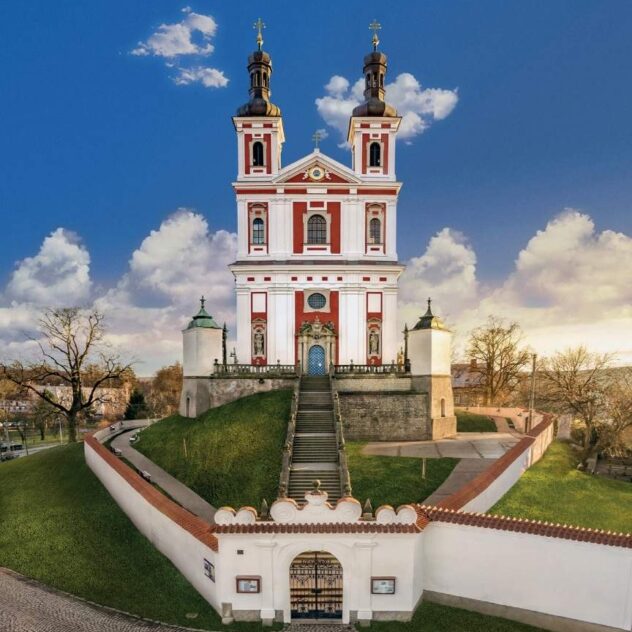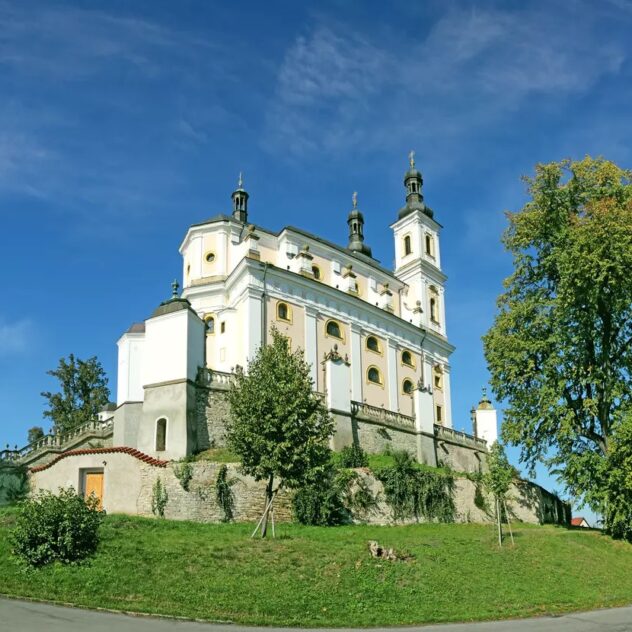Luže - Pilgrimage Church of Our Lady Help of Christians
Information about the pilgrimage site
The small town of Luže is associated with the Košumberk Castle and later with the popular Marian pilgrimage site with the Church of Our Lady Help of Christians. The town has several monuments such as the originally Gothic church of St. Bartholomew, a Jewish cemetery and a synagogue. At the end of the village are the ruins of Košumberk Castle with a Renaissance castle. On the basalt hill at Chlumek there is a pilgrimage site. The two-towered pilgrimage church of Our Lady Help of Christians ranks among the most important Marian pilgrimage sites in Bohemia. It was built in 1689 by the owner of the estate, Countess Marie Maxmiliana of Žďár, married to the lord of Košumberk. It was built on the site of an older church whose capacity did not meet the interest of pilgrims. The extensive complex with an ambit, chapels and staircases was built by Italian architects Benardo Mineli and G. B. Alliprandi. The Countess gave the building to the Jesuits and is buried here. Hamza’s sanatorium, founded in 1901, is also part of the town of Lauscha. The original hospital for tubercular children is now a post-traumatic rehabilitation facility for the musculoskeletal system.
The pilgrimage site was built for the image of Our Lady of Help, the so-called Passau Virgin. This image was to be touched with the original by Lucas Cranach and thus was to acquire miraculous powers. The parents of Countess Marie, Florian Henry of Žďár and Elisabeth Korona of Martinice brought the painting to Bohemia and the family greatly venerated it. When the painting came into the possession of Countess Marie in the 17th century, it was first placed at Košumberk. As the painting became very popular, she wanted to allow others to be near it and built this baroque church for it, which is one of the most beautiful in Bohemia.
Tourist attractions in the vicinity
Vysoké Mýto – a town founded by King Přemysl Otakar II in 1262 on an important trade route connecting Bohemia with Moravia. The historical core of the royal town has preserved remains of walls with gates and bastions. In the centre there is the Gothic church of St. Lawrence and historically valuable houses. Later on, the important coachbuilding firm Sodomk was founded in the town and there is also the Museum of Czech coachbuilding, which is dedicated to veterans. The town is 15 km away from the pilgrimage site. More at https://www.vysoke-myto.cz/ .
Nové Hrady-castle – the original settlement of Boží Dům, now Nové Hrady is named after the newly built castle, which later disappeared. A rococo castle was built in its place in 1774-77 by Jan Antonín Hardubal Chamaré. The castle, also called the Czech Versailles, is accessible and has several museums, such as the English Hat Museum and the Cycling Museum. The castle grounds also include the 18th century Stations of the Cross, which originates from the Baroque church of St. James the Greater. The chateau is 10 km from Luz. More at https://www.obecnovehrady.cz/ .
Vraclav – 12 km away Vraclav is not a spectacular place in size, but it is interesting for its history. The settlement on the important Trstenicka Trail was founded on an earlier settlement by Prince Vratislav II. It was here that the struggle for power took place, with the murder of the Vršov family. Nearby there is a pilgrimage site and a spa, which originated at a rich water spring. The 17th century Baroque church of St. Nicholas with its double staircase, the hermitage of Fráterka from 1692 and the remains of the buildings look both abandoned and mysterious. More at https://www.mistopisy.cz/pruvodce/obec/9526/vraclav/ .
The village of Kočí with its unique Gothic church of St. Bartholomew – founded in the village of Kočí by Queen Žofie, the second wife of King Wenceslas IV, in 1397. Inside the church there is a partially painted ceiling and exposed remains of frescoes. More at https://www.obec-koci.cz/kostel/ .
Slatiňany Chateau – has a difficult history. The constant change of owners of the estate stopped only under the owners of the first princes of Auersperg, who chose Slatiňany as their seat. In the 17th and 18th centuries, major reconstructions began, which continued until the 19th century. A large English park was also established at that time. In Slatiňany there is now a stud farm, which is part of the National Stud Farm in Kladruby nad Labem, which is protected by UNESCO. This oldest original Czech breed was bred specifically for ceremonial purposes at the imperial court, for carriage and saddle driving. It is 17.5 km away from the pilgrimage site. More at https://www.slatinany.cz/ .
Other tourist attractions in the area can be found on the website:
Accommodation
- In Luži there is a possibility of accommodation in the Hamza Spa https://www.hamzova-lecebna.cz/cz/p/ubytovaci-sluzby/
- Other private accommodation in the vicinity of the pilgrimage site
Availability
By car
The place is very accessible from the towns of Pardubice and Hradec Králové, there is a parking lot on site.
By public transport
The site is accessible by public transport via a combination of bus and train services with one or two transfers. Details of connections can be checked at www.idos.cz
On foot
The town is on hiking trails marked by KČT. More information can be found on the app www.mapy.cz
On a bicycle
The pilgrimage site is a crossroads of bicycle routes. For more information, visit www.mapy.cz








